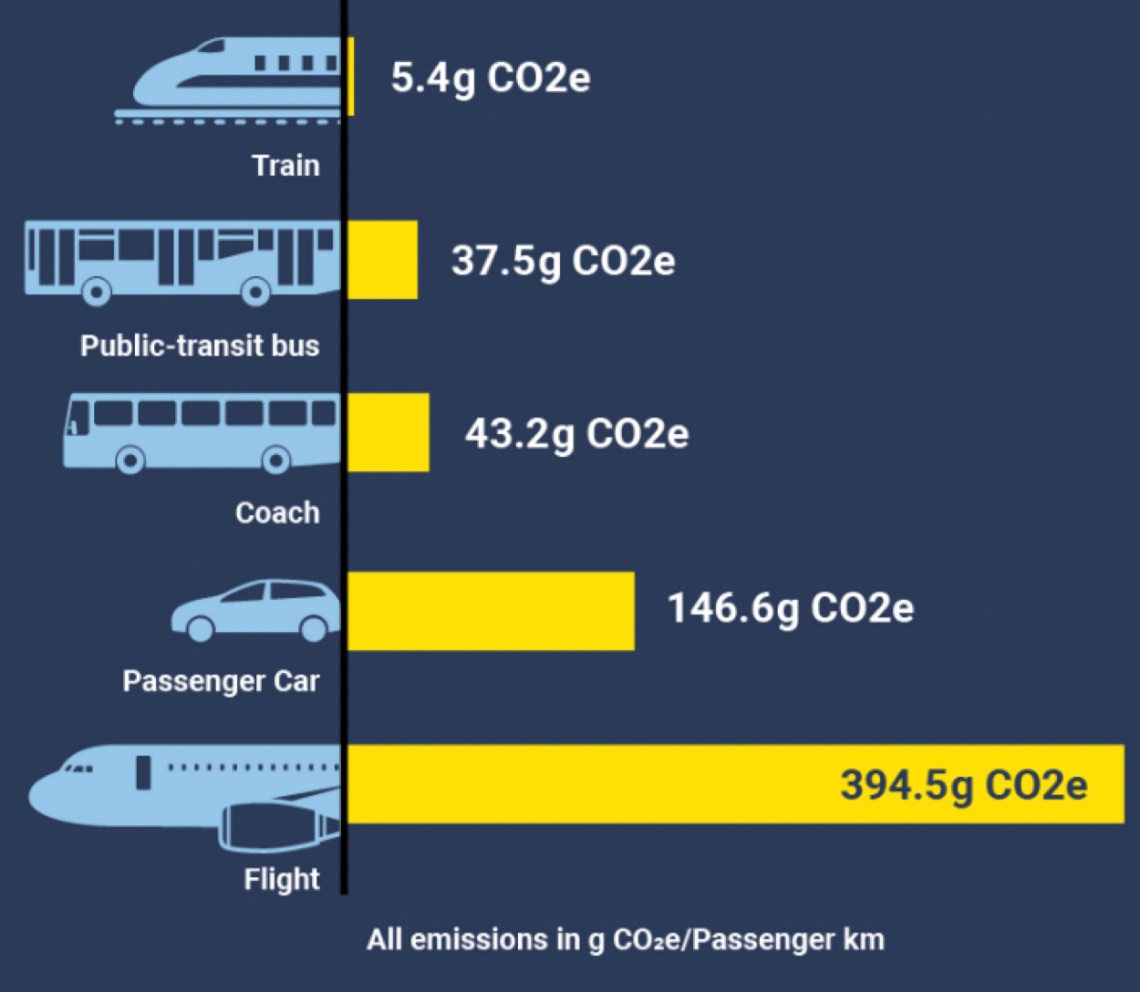
Airplanes can take us to the other side of the world in just half a day—but not without a significant cost. In addition to expensive airfare, flying releases a large amount of greenhouse gases into the atmosphere. Concerned about the environmental impact of aviation emissions, some people have proposed the no-fly or flight-free movement. Originating in Sweden, this movement has sparked strong social responses in various regions and contributed to a 20% drop in the number of air travelers in Sweden in 2023.
Meanwhile, last year, many places around the world suffered from severe over-tourism. As the COVID-19 pandemic subsided, countless people sought to reclaim the freedom of travel they had missed. The surge of tourists worldwide caused popular destinations to struggle with rising housing prices, overflowing waste, and water shortages. According to the UN World Tourism Organization, the number of international travelers worldwide reached approximately 285 million in March of this year—a 20% increase compared to the same period last year. The boom in overseas travel made the skies busier than ever before.
On one hand, the large number of people flying and traveling is causing problems, while on the other hand, the sharp decline in passengers due to the no-fly movement is putting the aviation industry in crisis. What does sustainable travel look like—one that is neither excessive nor insufficient?
Greenhouse Gas Emissions from Airplanes
Airplanes have only become widely used relatively recently. It was around the time of World War II, with the development of jet engines, that airplanes truly grew as a mode of transportation for people. While greenhouse gases that trigger climate change began to be emitted into the atmosphere around 1850 during the Industrial Revolution, greenhouse gas emissions from the aviation sector started about 100 years later, around the 1940s. As a result, the aviation sector accounts for only about 2–3% of the cumulative greenhouse gas emissions since 1940. The real concern is the future. Currently, the aviation sector is responsible for about 6% of global annual greenhouse gas emissions. With the rapid increase in global air travel, this share is projected to rise to as much as 22% by around 2050.

Airplanes are one of the largest carbon-emitting modes of transportation. When a passenger travels 1 kilometer by plane, approximately 394.5 grams of CO2 equivalent (CO2e) are emitted. In comparison, traveling the same distance by car emits 146.6g CO2e, by bus 37.5g CO2e, and by train only 5.4g CO2e. This means that airplanes emit about 2.7 times more than cars and 70 times more than trains. So, what are some ways to travel by plane while minimizing greenhouse gas emissions?
Sustainable Aviation Fuel made from Waste Oil and Biomass
The real issue is fuel. The most commonly used aviation fuel today is jet fuel, which is processed kerosene with various additives. Besides carbon dioxide, it also emits other greenhouse gases and pollutants such as nitrogen oxides, sulfur oxides, and soot. While cars are transitioning from internal combustion engines to electric vehicles to reduce greenhouse gas emissions and airborne fine dust, could electrifying airplanes solve the problem? Unfortunately, aviation is one of the most challenging sectors to electrify due to technical limitations like energy density, battery weight, and charging time. So, what’s left? That’s right—changing the fuel.
In November last year, Virgin Atlantic, a UK-based commercial airline, attracted significant media attention with its flight from London to New York. It was the world’s first flight operated using 100% Sustainable Aviation Fuel (SAF)! SAF refers to aviation fuel produced from renewable sources or waste materials instead of fossil fuels, reducing carbon emissions by up to 80% over its entire lifecycle compared to conventional jet fuel. There are various types of SAF, but the most common are biofuels made from biomass such as vegetable oils, waste cooking oil, animal fat waste, agricultural and forestry residues, and purpose-grown crops. Virgin Atlantic’s 100% SAF flight demonstrated the remarkable fact that airplanes can be powered by waste cooking oil and agricultural residues.

The initial excitement soon turns into skepticism. If 100% SAF flights are possible, why aren’t more airlines fully embracing this fuel? There are two main reasons. First, from a technical standpoint, fuel standards currently limit the SAF blending ratio to a maximum of 50% to ensure engine performance and safety. Second, the production cost of SAF is significantly higher than that of conventional jet fuel. Therefore, this flight was more of a ceremonial milestone marking the dawn of the SAF era as the next-generation fuel that the aviation industry is watching closely. Currently, SAF accounts for only 0.1% to 0.2% of the aviation fuel market. However, it is important to note that the market is growing rapidly. Experts predict that the SAF market will grow from $1.3 billion in 2023 to $41.6 billion by 2032—an increase of more than 30 times within the next decade. In the United States, the Inflation Reduction Act (IRA) aims to increase SAF production to 3 billion gallons by 2030 and 35 billion gallons by 2050. Likewise, the South Korean government announced a roadmap to mandate a 1% SAF blending ratio on all international flights starting in 2027. According to the International Civil Aviation Organization (ICAO), sustainable aviation fuel is the most promising means of reducing greenhouse gas emissions and achieving carbon neutrality in the aviation sector in the medium to long term.
Captain, please take the Shortest and Highest Route!
Both cars and airplanes need to practice eco-driving to reduce greenhouse gas emissions and save fuel. For cars, eco-driving means choosing the optimal route, maintaining a proper speed, and avoiding sudden braking and rapid acceleration. For airplanes, it’s important to develop shorter flight paths and optimize flight altitude, speed, and aircraft weight.

At first glance, it might seem that flying at a lower altitude would save fuel and shorten the flight distance, thereby reducing greenhouse gas emissions. However, the opposite is true—higher altitudes are better. At higher altitudes, the atmosphere is more stable, turbulence is reduced, and lower air density decreases drag, which improves fuel efficiency and shortens flight time. That said, the actual flight altitude is not always set at the maximum possible level because there are many factors a pilot must consider. These include: △The engine and aerodynamics of the specific aircraft model, △The total weight of the aircraft, including cargo, passengers, and fuel, △Weather conditions such as wind, temperature, and pressure, △Air traffic volume, route congestion, airspace structure, and related air traffic control regulations and guidelines, △Fuel efficiency, and △Passenger comfort and safety. The pilot must select an altitude that allows the aircraft to take advantage of the most favorable air currents while balancing fuel and time savings. However, even the most experienced pilots would find it difficult to calculate all these factors in real time to perform a “climate-optimized flight.” Therefore, it is necessary to develop an advanced altitude management system combined with AI that can analyze real-time atmospheric data and propose climate-optimized flight paths that best balance fuel efficiency and passenger safety.
I don’t mind sitting tight!
While the pilot practices eco-driving, passengers also have a role to play. When purchasing plane tickets and packing their bags, they can make choices that reduce greenhouse gas emissions. These choices often mean sacrificing a bit of convenience. In fact, the journey begins when you start packing. Many travelers bring items just in case they might need them, wear them, or want to eat them at the destination. However, as mentioned earlier, the aircraft’s weight is a major factor affecting fuel efficiency. Packing only what’s necessary and keeping your luggage as light as possible is a warm-up for low-carbon flying.

The less luggage passengers carry, the better, but the more passengers an aircraft carries, the lower its greenhouse gas emissions per person. Filling a flight to maximum capacity is beneficial both economically and environmentally. Low-cost airlines and economy class seats, which often have narrower seat spacing but carry more passengers, have a smaller carbon footprint. Some flight booking websites provide information on the greenhouse gas emissions associated with each flight, allowing travelers to check their carbon footprint before purchasing tickets. Whenever possible, it’s better to use digital tickets rather than printed paper ones. Also, some airlines have policies restricting single-use items, so this is another factor to consider.
Still a Long Way to Go
Whether or not the aviation sector achieves carbon neutrality, the aviation technology market is rapidly evolving. Supersonic passenger planes, which disappeared from the market 20 years ago, are making a spectacular comeback. Boom Technology, a U.S. company, is developing a supersonic aircraft that significantly reduces sonic booms and has already received pre-orders for over a hundred planes from commercial airlines. Supersonic planes are literally “gas guzzlers.” The Concorde, which operated briefly in the past, burned about 25,600 liters of fuel per hour. Although Boom Technology’s latest supersonic aircraft uses much less fuel than the Concorde and is operated entirely on 100% SAF, it still consumes 2 to 3 times more fuel per seat compared to a standard passenger plane, even for premium seats.

But just as dawn comes even if you strangle the rooster, technologies that make life more convenient will inevitably expand—even if greenhouse gas emissions from the aviation sector remain a problem. Hydrogen-powered planes, currently in a slump, will one day soar through the skies. Perhaps supersonic hydrogen aircraft will open a new chapter in the history of passenger aviation. The real climate villains are not the travelers who take flights, but the outdated regulations and systems that block carbon neutrality in aviation and the negative inertia that resists innovation.
▶ This article is a contribution to the webzine published by the Korea National Oil Corporation.
https://www.knoc.co.kr/upload/EBOOK/sabo/203/sub/sub2_4.html











